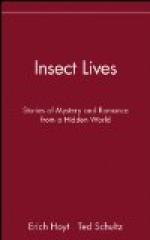The caterpillar differs markedly from the butterfly. As we pursue our studies of insect growth and transformation we shall find that in some cases the difference between young and adult is much greater—as for example between the maggot and the house-fly, in others far less—as between the young and full-grown grasshopper or plant-bug. It is evidently wise to begin a general survey of the subject with some of those simpler cases in which the differences between the young and adult insect are comparatively slight. We shall then be in a position to understand better the meaning of the more puzzling and complex cases in which the differences between the stages are profound.
In the first place it is necessary to realise that the changes which any insect passes through during its life-story are essentially accompaniments of its growth. The limits of this little book allow only slight reference to features of internal structure; we must be content, in the main, to deal with the outward form. But there is an important relation between this outward form and the underlying living tissues which must be clearly understood. Throughout the great race of animals—the Arthropoda—of which insects form a class, the body is covered outwardly by a cuticle or secretion of the underlying layer of living cells which form the outer skin or epidermis[3] (see fig. 10 ep, cu, p. 39). This cuticle has regions which are hard and firm, forming an exoskeleton, and, between these, areas which are relatively soft and flexible. The firm regions are commonly segmental in their arrangement, and the intervening flexible connections render possible accurate motions of the exoskeletal parts in relation to each other, the motions being due to the contraction of muscles which are attached within the exoskeleton.
[3] The term ‘hypodermis’ frequently applied to this layer is misleading. The layer is the true outer skin—ectoderm or epidermis.
Now this jointed exoskeleton—an admirably formed suit of armour though it often is—has one drawback: it is not part of the insect’s living tissues. It is a cuticle formed by the solidifying of a fluid secreted by the epidermal cells, therefore without life, without the power of growth, and with only a limited capacity for stretching. It follows, therefore, that at least during the period through which the insect continues to grow, the cuticle must be periodically shed. Thus in the life-story of an insect or other arthropod, such as a lobster, a spider, or a centipede, there must be a succession of cuticle-castings—’moults’ or ecdyses as they are often called.




